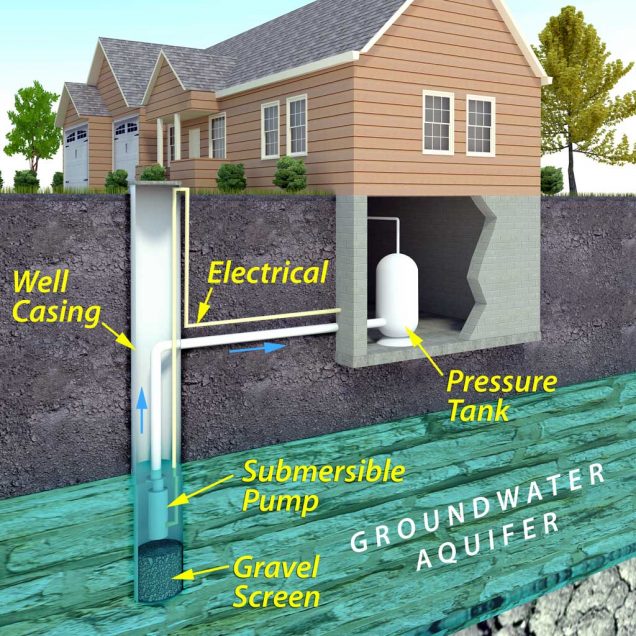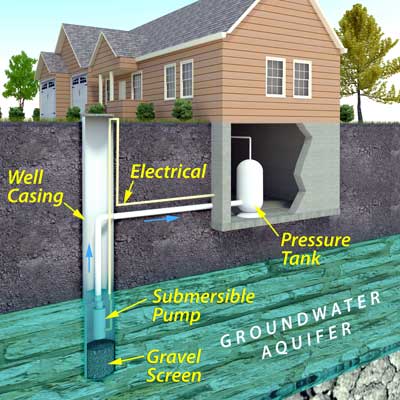Many people take having fresh, clean water for granted, but in Connecticut an effective well water system is the foundation of a safe and reliable home water supply. Most private wells in our state fall into one of three categories: drilled wells, driven wells, or dug wells. Each type has unique construction methods, advantages, and risks.
Below, we’ll break down the three main types of wells used in Connecticut so you can better understand how they work and which option may be right for your property.
Drilled Wells
Drilled wells are the most common and reliable type of well water system used in Connecticut. They are created using rotary drilling machines or cable tool (percussion) methods and can extend hundreds of feet below the ground, sometimes reaching depths of up to 1,000 feet. Because they tap into deep aquifers, drilled wells generally provide the cleanest and most dependable water supply.
To protect the well, a sealed casing is installed to maintain structural integrity. When drilled into unconsolidated materials such as sand or gravel, the well also requires a screen to prevent collapse and block sediment from entering. The space around the casing is then sealed with grouting material such as bentonite clay or cement. This barrier prevents surface runoff and contaminants from seeping into the water supply, which is especially important in Connecticut where seasonal rains and snowmelt can increase groundwater risks.
Driven Wells
Driven wells are a simpler and more economical well water option often found in certain parts of Connecticut. They are created by driving a small-diameter pipe into water-bearing sand or gravel. Depths usually range from about 30 feet if installed by hand, to 50 feet or more when machine-driven.
A screened well point is placed at the bottom of the casing to filter out sand and sediment as water enters. Because of their shallow depth, driven wells are best suited to areas with a high water table and coarse soils. They are also one of the quickest and most cost-effective well types to construct. However, they are rarely used any longer for homes that are occupied on a year round full time basis.
However, driven wells come with trade-offs. Since they are not sealed with grout, they are more vulnerable to contamination from surface water. This makes them less reliable during Connecticut’s seasonal storms, snowmelt, or heavy runoff. Homeowners with driven wells should be especially vigilant about regular inspections and water testing to ensure safety.
Dug Wells
Dug wells are the oldest and most traditional type of well, created by hand-digging into the ground until reaching the water table. Historically, every household relied on this method before modern drilling equipment became available.
These wells are typically shallow and wide. To prevent collapse, the walls are lined with stone, brick, or concrete, and the top is capped with wood, stone, or concrete. While this construction method provided basic access to water in the past, it comes with serious drawbacks today.
Because dug wells are shallow and not sealed against surface water, they are highly vulnerable to contamination from runoff, flooding, and seasonal changes. In Connecticut, where heavy rains, snowmelt, and changing groundwater levels are common, dug wells present significant risks to water safety. They can also run dry more easily during drought conditions.
For these reasons, dug wells are no longer recommended for Connecticut homes. Homeowners seeking a safe and reliable water supply should consider a drilled well, or in some cases a driven well, as more modern alternatives.
Which Type of Well is Right for Your Home?
Choosing the right well depends on factors like your property’s soil conditions, water table depth, and long-term water needs. In general:
- Drilled wells are the most reliable and safest option for Connecticut homeowners. They reach deep aquifers, last for decades, and are protected from surface contamination.
- Driven wells are economical and can work well in certain soil conditions with a high water table, but they are shallower and more prone to contamination.
- Dug wells are no longer recommended due to their shallow construction and high risk of pollution and running dry.
At Greco & Haines, we’ve been helping Connecticut homeowners make the right well choices since 1963. Whether you need a new well installation, service for an existing system, or expert guidance on which type of well is best for your property, our well water system mechanics are here to help.
Call us today to schedule an inspection or emergency service anywhere in Connecticut. If you have questions about your well system or need expert assistance, Greco & Haines is here to help. With a longstanding reputation for quality service across Connecticut, we’re dedicated to keeping your water supply clean, safe, and reliable. Give us a call anytime at 203-735-9308, 203-777-2256, or toll-free from any CT area code at 1-800-922-2958.


